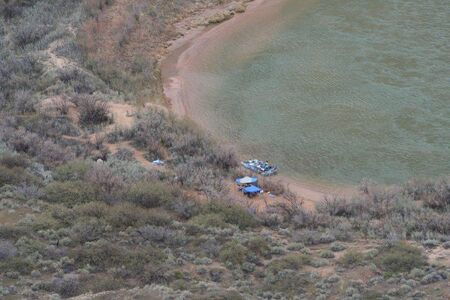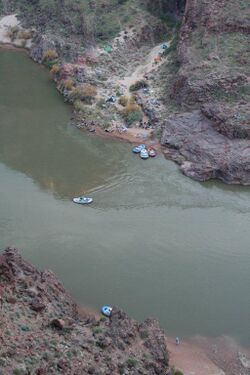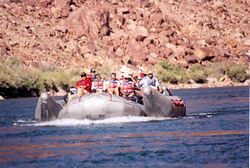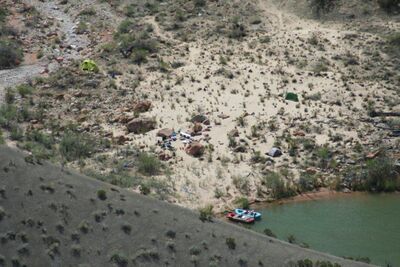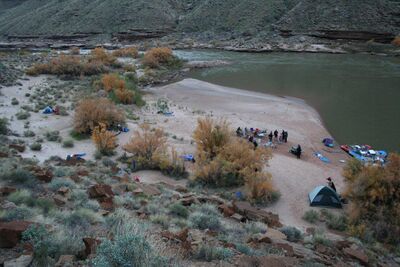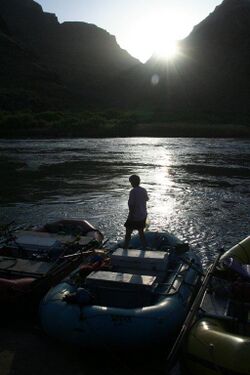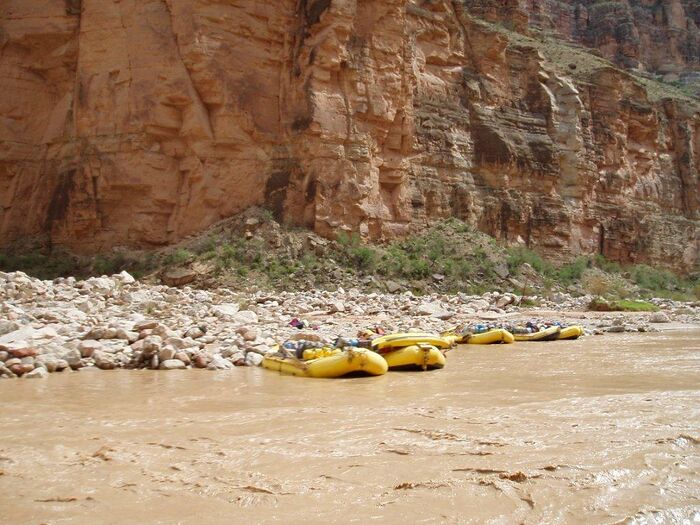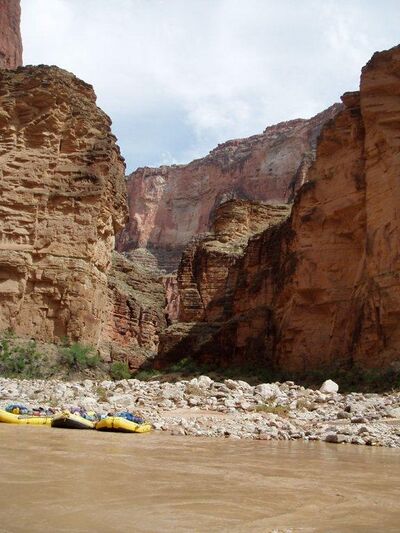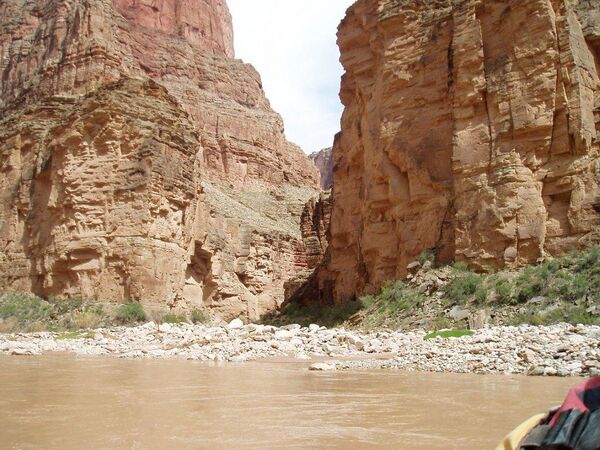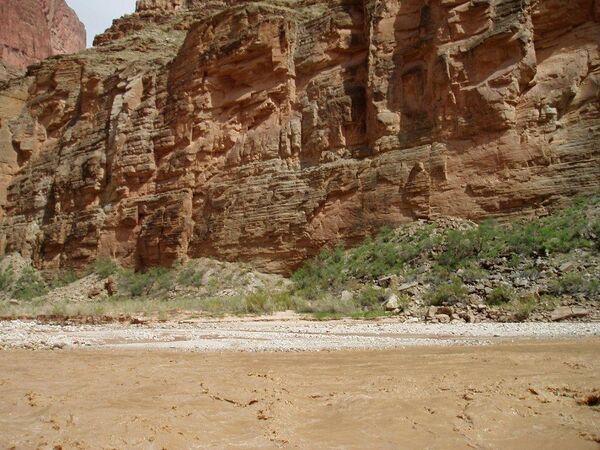Campsites
Every night, you and your team, along with every other river trip between Lee's Ferry and Lake Mead, will be looking for a place to camp.
The photo on the right shows a five boat sixteen person trip doing a layover at the Main Nankoweap Camp.
Choosing a camp location is driven by many factors, including nearby activities like side hikes, what time of the afternoon is it, are you planning to spend two nights at the same camp (called a Layover), how far do you need to go tomorrow, where are other trips upstream and downstream of you going to camp. Other things to consider include is there shade there or an overhang to get out of a monsoon rain shower. Finally, once at camp, besides keeping a clean campsite, what will the river fluctuations do to your boats tied to shore, and how big is the campsite footprint.
We'll cover all the above points one at a time.
There are a large number of campsites in Grand Canyon, with roughly one camp a mile from Lee's Ferry the 226 miles to Diamond Creek. Sometimes there will be a few camps together, like the four camps in the mile and a half from Little Nankoeweap, Upper, Main and Lower Nankoweap, or the three camps at 220 Mile, Upper Middle and Lower.
There may be miles between camps in some places, especially the Upper Granite Gorge reach from Hance to Phantom Ranch where in an eleven mile section of river there are only seven camps, and a few of those camps are very small indeed. Below Diamond Creek, once you drop below the Burnt Springs Quartermaster area, it is not uncommon (in 2010) to go 10 miles with no place to camp at all.
Resources on campsites include a link to the National Park Service Campsite Atlas. Besides the on-line Atlas, the two books, Day Hikes from the River and Guide to the Colorado River in Grand Canyon, are very helpful in pre-trip planning on where you would like to go on your trip and what you would like to see. These resources will be helpful in deciding a rough trip itinerary and are available at the River Runners for Wilderness on-line store. For itinerary help, see the page titled Itineraries.
Campsite Considerations include...
Location, Location Location... Some camps, like the Main Nankoweap Camp, Bass Camp and Across From Deer Creek, are very popular camps. If there is good side canyon hiking, as is the case with all of the camps in the last sentence, expect to find other trips on the water who want to camp at these places too.
These river runners are doing a layover at the popular Across from Deer Creek Camp. A river runner is ferrying a boat across the river to pick up a hiker who has been hiking at Deer Creek and now wants to get back to camp across the river. The NPS does not allow camping on the north side of the river at Deer Creek Falls proper.
Some camps are upstream of attraction sites, and they will be popular too. An example of these camps might be Racetrack or Talking Heads, both just above the popular Tapeats Creek.
Who Is Behind You?
One of the things to consider when thinking about where to camp is about other trips on the water. You may have already "agreed" with the other trips around you about where everyone will be camping, and then look back over your shoulder late in the day to see this, a motor rig bearing down on your oar trip. You know that motor trip knows nothing about the plans you have made with the other trips around you. At this point you are at the mercy of the river guide running the motor rig. Some motor guides are great. They would never, NEVER, pull in front of you, would NEVER pass you without so much as a "How's it going?" and would NEVER take the camp you had arranged with others to camp at. Unfortunately, well, it doesn't always work that way, and you may find yourself aced out of the camp you all had agreed on. You will have no choice but to head on downriver and camp someplace else. What you and your crew can do is to make sure every boat rower knows where you are "intending" to camp for the night. That way, if the motor boat guide throttles down to ask about where you are planning to camp, any one in your team can answer kindly and correctly about what your intentions are. It's all about friendly communication, and you will be much better off if all of your team can answer that all important question to anyone who asks..."Hey, where you campin tonight?"
Grand Canyon Tides
You will also want to consider your choice of camps depending on what the projected flow out of Glen Canyon Dam is doing. Is the water going down overnight? That's what happened to these river runners in the photo on the Tide Tables page.
Respecting Campsite Footprints
Every campsite has a footprint. It's where the kitchen, group sitting area, bathroom and personal campsites all go. The Campsite footprint is in most cases well below the historic high water line. The campsite footprint is also typically on durable surfaces, like debris fans. You can help the Canyon out by not pioneering a campsite where there was none before. If you see an area closed off with vegetation laid across trails, don't move the brush and set up camp. This may be an area that the National Park Service is trying to re-vegetate.
Time to Get Off the Water In the summer when the days are longer and the air temperatures hotter, finding a camp late in the day is not as much of a safety hazard as it is in the winter, when a late day swim in the river may seriously jeopardize a river trip. In the December-February months, some trips will be getting off the water by 3:30 or so in the afternoon. That is a good idea, as folks will be getting cold, reaction times will be slowing, and it will be pitch dark in only another two hours. In the summer, it is typically too hot to pull into camp this early, and most folks will boat till 4:30 or even 5:30-6:00ish.
Recent Changes In July of 2012, the delta camp at National Canyon was for the most part over-topped by a flash flood caused by a summer monsoon. The far lower end of this delta is still camp-able, but the upper end is at this time a boulder field. The RGC Wiki team thanks Bev Kurtz for the following four images taken in August 2012:
Click here to return to The Trip page.
